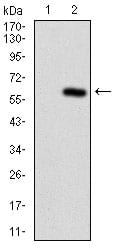APC Primary Antibody
Item Information
Catalog #
Size
Price
Description
This gene encodes a tumor suppressor protein that acts as an antagonist of the Wnt signaling pathway. It is also involved in other processes including cell migration and adhesion, transcriptional activation, and apoptosis. Defects in this gene cause familial adenomatous polyposis (FAP), an autosomal dominant pre-malignant disease that usually progresses to malignancy. Disease-associated mutations tend to be clustered in a small region designated the mutation cluster region (MCR) and result in a truncated protein product.
Product Overview
Entrez GenelD
324
Aliases
GS; DP2; DP3; BTPS2; DP2.5; PPP1R46
Clone#
1F7G2
Host / Isotype
Mouse / IgG1
Species Reactivity
Human
Immunogen
Purified recombinant fragment of human APC (AA: 2644-2843) expressed in E. Coli.
Formulation
Purified antibody in PBS with 0.05% sodium azide.
Storage
Store at 4°C short term. Aliquot and store at -20°C long term. Avoid freeze/thaw cycles.
Product Applications
WB (Western Blot)
1/500 - 1/2000
FCM (Flow Cytometry)
1/200 - 1/400
ELISA
1/10000
References
1. Gastroenterology. 2012 Jan;142(1):71-77.
2. Mol Cancer. 2011 Aug 22;10:101.
2. Mol Cancer. 2011 Aug 22;10:101.
Product Image
Western Blot

Figure 1: Western blot analysis using APC mAb against human APC (AA: 2644-2843) recombinant protein. (Expected MW is 47.4 kDa)
Western Blot

Figure 2: Western blot analysis using APC mAb against HEK293 (1) and APC (AA: 2644-2843)-hIgGFc transfected HEK293 (2) cell lysate.
Flow cytometric

Figure 3: Flow cytometric analysis of Hela cells using APC mouse mAb (green) and negative control (red).
Elisa

Black line: Control Antigen (100 ng); Purple line: Antigen(10ng); Blue line: Antigen (50 ng); Red line: Antigen (100 ng);
For Research Use Only. Not for use in diagnostic procedures.

